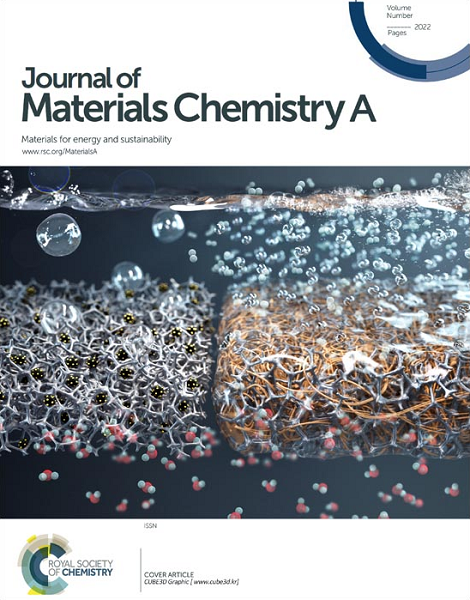重新利用pva基黏液来解决便携式电化学设备中的电解质挑战
IF 9.5
2区 材料科学
Q1 CHEMISTRY, PHYSICAL
引用次数: 0
摘要
面向应用的材料正在快速发展,与现有的选择相比,每种材料都提供了增强的性能。虽然很明显,这些材料被证明对预期的应用有积极的贡献,但由于多种原因,它们往往不能转化为商业利用。一些原因是缺乏现成的原料,它们的高成本或需要多步骤的合成程序。在某些情况下,报告的材料保质期只评估了很短的一段时间,或者在模拟加速条件下进行了研究,这在现实生活中可能会有所不同。所有这些因素都对其商业化构成了重大障碍。在这种情况下,重新利用适当的商业上可获得的材料,为新的应用提供了延长的保质期和成本效益,是减少商业部署所需时间的可行途径。本文重点介绍了聚乙烯醇(PVA)基黏液作为便携式电化学装置电解质的再利用范围。电化学测量需要有足够的盐来保证离子电导率。传统的液体电解质溢出或渗漏到下表层时,会引起腐蚀。具有良好流动性能的防溢电解质是原位电化学探针发展的关键。目前正在广泛探索的凝胶电解质有其自身的挑战。黏液最初是作为一种感官玩具销售的,由于其低成本、惰性、生物相容性、可剥离性和长保质期,它有可能被用作电解质,因为其中的硼砂提供了足够的离子导电性。因此,pva基黏液具有独特的组合特性,是一种潜在的材料,可以作为液体电解质和传统聚合物凝胶的另一种替代品。然而,到目前为止,这种介质只是从提高机械性能的角度来设计的,以适应应用。本工作分析了工程泥浆介质增强流动特性的前景,以实现高离子电导率和一致性,同时保持其可剥性和防溢性。本文章由计算机程序翻译,如有差异,请以英文原文为准。

Repurposing PVA-based slime to address electrolyte challenges in portable electrochemical devices
Application-oriented materials are being developed at a rapid pace, each providing enhanced properties compared to the existing options. While it is evident that these materials are proven to contribute positively to the intended application, they are often not translated to commercial utilization due to multiple reasons. Some of the reasons are the lack of ready availability of raw materials, their high cost or the requirement of multistep procedures of synthesis. In some cases, the reported shelf life of the material was evaluated only for a short span or has been studied under simulated accelerated conditions, which may vary in real-life scenarios. All these factors pose significant hurdles to their commercialization. Under such circumstances, repurposing appropriate commercially available materials, which exhibit enhanced shelf life and cost-effectiveness for novel applications, presents a feasible route to reduce the time required for commercial deployment. This perspective paper focuses on the scope of repurposing poly vinyl alcohol (PVA)-based slime as an electrolyte for portable electrochemical devices. An electrochemical measurement necessitates the presence of adequate salts for ionic conductivity. The conventional liquid electrolytes cause corrosion when spilled or seeped into the underlying surface. A spill-proof electrolyte with adequate flow properties is crucial for the development of in situ electrochemical probes. The gel electrolytes, which are currently being explored widely, have their own challenges. Originally marketed as a sensory toy, due to its low cost, inert, biocompatible nature, strippability, and long shelf life, slime has the potential to be used as an electrolyte because of the fact that borax in it provides sufficient ionic conductivity. Thus, PVA-based slime with its unique combination of characteristics is a potential material to be explored as another alternative to liquid electrolyte and conventional polymeric gels. However, to date, the medium has only been engineered from the perspective of improving mechanical properties to suit applications. This work analyzes the perspective of engineering slime medium for enhanced flow properties to achieve high ionic conductivity and conformability while retaining its strippability and spill-proof nature.
求助全文
通过发布文献求助,成功后即可免费获取论文全文。
去求助
来源期刊

Journal of Materials Chemistry A
CHEMISTRY, PHYSICAL-ENERGY & FUELS
CiteScore
19.50
自引率
5.00%
发文量
1892
审稿时长
1.5 months
期刊介绍:
The Journal of Materials Chemistry A, B & C covers a wide range of high-quality studies in the field of materials chemistry, with each section focusing on specific applications of the materials studied. Journal of Materials Chemistry A emphasizes applications in energy and sustainability, including topics such as artificial photosynthesis, batteries, and fuel cells. Journal of Materials Chemistry B focuses on applications in biology and medicine, while Journal of Materials Chemistry C covers applications in optical, magnetic, and electronic devices. Example topic areas within the scope of Journal of Materials Chemistry A include catalysis, green/sustainable materials, sensors, and water treatment, among others.
 求助内容:
求助内容: 应助结果提醒方式:
应助结果提醒方式:


